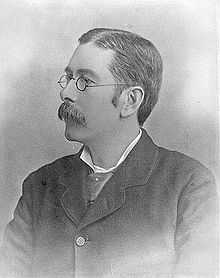Thomas Jeffery Parker

Thomas Jeffery Parker F.R.S. (17 October 1850 – 7 November 1897) was a zoologist who worked in New Zealand.
Biography
Parker was born in London on 17 October 1850;[1] his father was the anatomist William Kitchen Parker.[2][3] He studied at Clarendon House School and graduated from the University of London in 1868.[1]
At the age of 22, he worked with Thomas Henry Huxley in Huxley's zoological demonstrations.[4] Huxley's work on crayfish kindled in Parker an interest in crustaceans, and he went on to study the marine "crayfish" (spiny lobsters) of New Zealand, together with his student Josephine Gordon Rich, who later married William Aitcheson Haswell.[5]
On 23 December 1874, Thomas Jeffery Parker married Charlotte Elizabeth Rossell in Bramley, Yorkshire.[1] In 1880, they emigrated to New Zealand, becoming professor of zoology at the University of Otago in Dunedin,[6] succeeding Frederick Wollaston Hutton.[1] He was also curator of the Otago Museum.[1] Parker was made a Fellow of the Royal Society on 7 June 1888.[7]
In his later years, Parker suffered from diabetes, and he died on 7 November 1897 at Warrington.[1] After his death, Parker was succeeded at the University of Otago by William Blaxland Benham.[4]
Works
Parker produced more than 40 scientific papers.[1] They include nine papers on moas published between 1889 and 1895.[4] Despite living in different countries, Parker wrote an introductory textbook on zoology together with William Aitcheson Haswell, which continued to be used into the 1960s.[4]
Memoirs on New Zealand animals
- “On the Structure and Development of Apteryx”
- “On the Cranial Osteology, Classification, and Phylogeny of the Dinornithidæ”
Books
- Zoötomy (1884)
- Lessons in Elementary Biology (1890)
- A Text-book of Zoölogy (with W. A. Haswell, 1897); 7th edition
Notes
- ↑ 1.0 1.1 1.2 1.3 1.4 1.5 1.6 A. Warwick Don (1 September 2010). "Parker, Thomas Jeffery - Biography". Dictionary of New Zealand Biography. Te Ara – the Encyclopedia of New Zealand. Retrieved 18 December 2011.
- ↑ Ruby Louise Gough (2005). Robert Edwards Holloway: Newfoundland Educator, Scientist, Photographer, 1874-1904. McGill-Queen's University Press. p. 231, footnote 45. ISBN 978-0-7735-2852-9.
- ↑ Patricia Morison (1997). J. T. Wilson and the Fraternity of Duckmaloi. Clio medica 42. Rodopi. p. 454. ISBN 978-90-420-0232-6.
- ↑ 4.0 4.1 4.2 4.3 Trevor H. Worthy & Richard N. Holdaway (2002). The Lost World of the Moa: Prehistoric Life of New Zealand. Indiana University Press. p. 20. ISBN 978-0-253-34034-4.
- ↑ Mary R. S. Creese, Thomas M. Creese (2010). Nineteenth and Early Twentieth Centuries. Ladies in the Laboratory. South African, Australian, New Zealand, and Canadian Women in Science III. Scarecrow Press. p. 108. ISBN 978-0-8108-7288-2.
- ↑ David McKitterick (2004). "Macmillan". New Worlds for Learning, 1873-1972. A History of Cambridge University Press 3. Cambridge University Press. pp. 57–68. ISBN 978-0-521-30803-8.
- ↑ "List of Fellows of the Royal Society 1660–2007" (PDF). The Royal Society. July 2007. Retrieved 18 December 2011.
References
-
 "Parker, Thomas Jeffery". New International Encyclopedia. 1905. Source for the list of works. NIE used his zoology text for its animal classication needs.
"Parker, Thomas Jeffery". New International Encyclopedia. 1905. Source for the list of works. NIE used his zoology text for its animal classication needs.
|